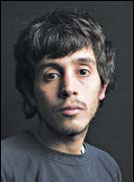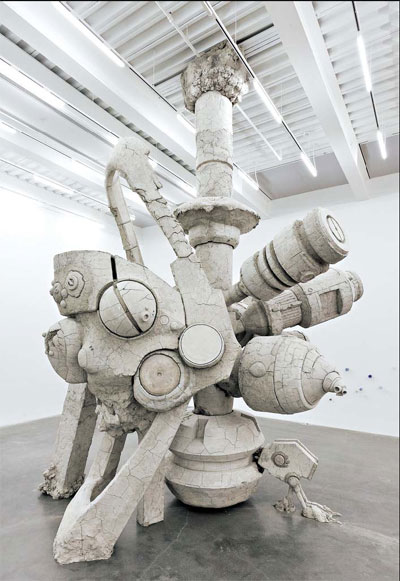A colossus in clay sends a message
Updated: 2012-03-04 07:47
By Randy Kennedy (The New York Times)
|
|||||||||||
|
"A person loved me" by the Argentine sculptor Adrian Villar Rojas, left, at the New Museum. [Robert wright for The New York Times] |
Ruins of the future from a fast new art crowd
Any visitor to the New Museum in New York in early February might have thought that the fourth floor was being gutted. It was almost impossible to walk without stepping on a piece of wood or a pile of rubble.
But there was something odd about this scene of destruction: in the middle of it all, a kind of rough gray tower of what appeared to be cement rose from floor to ceiling.
The object, titled "A person loved me" and one of the showstoppers at "The Ungovernables," the museum's ongoing Triennial, was made using mostly clay, one of the world's oldest and plainest art-making materials. A crew of six men and women from Argentina assembled, shaped and carved the piece, working seven days a week for a month under a 31-year-old sculptor named Adrian Villar Rojas.
Mr. Rojas, who was raised and educated in Rosario, Argentina's third-largest city, was chosen to represent his country in the 2011 Venice Biennale, where a towering forest of his deranged clay structures became an unexpected hit.
He began using clay partly because it was cheap and plentiful and its crude physicality tacked against the ethereal look of a lot of Conceptualist-influenced work by established Argentine artists. But the clay itself began to shape his ideas about the kind of work he wanted to make.
"Look at this, we finished this only yesterday," he said, showing a visitor a piece of the sculpture. Mottled gray and scarred by deep cracks, it looked as if it could have just been unburied by archaeologists.
"It's an instant ruin," said Mr. Rojas, who looked almost ancient himself, his hair and glasses dusted with clay powder. "It's the gift the material gives us."
He thinks of such pieces as ruins from the future, the wreckage of civilizations yet to come.

Like many ruins, the piece itself will be demolished, not long after the Triennial ends on April 22, both because there is no good way to take it apart to get it out of the museum and because, Mr. Rojas says, "I really love the idea of not having a body of work."
The crew that helps build his monstrosities is less like a group of studio assistants than like a band, with Mr. Rojas as lead singer and one of the songwriters. Over the last two years, as his star has ascended, the group has traveled like a band on extended tour, tramping from Ecuador to Germany to Mexico to Colombia to Italy to France and now to New York, creating pieces in each place as a kind of impromptu performance. While the sculptures are not improvised, exactly, they incorporate ideas from everyone in the group and evolve as they are built.
The group's modus operandi, to be constantly in motion and seeming to make up the rules for itself as it goes, is one of the few readily identifiable things it shares with the 34 individual artists, artist groups and temporary collectives who make up the Triennial.
The show's curator, Eungie Joo, spent a year and a half traveling to more than 20 countries to choose the participants, most born between the mid-1970s and the mid-1980s. Eating lunch in the museum's lobby recently with Mr. Rojas, she said the first thing she had to recognize as she set out to assemble a representative picture of the work of young artists around the world - the goal of the Triennial - was that "it's a mission that admits its failure before it starts"; the generation is just "too diverse and complex for many kinds of generalizations."
But she saw these artists as united by having come of age in an era of disillusionment, many in countries and regions that had overthrown colonialism only to suffer under dictatorships, global economic crises and other endemic political and cultural problems. (The show, with a concentration on the Middle East, Asia and South America, includes only three American-born artists.)
Though Ms. Joo started her search before the inception of Occupy Wall Street and even before the first Arab Spring uprisings, the motivating spirit of both movements seems to suffuse the show.
Jonathas de Andrade, 29, a Brazilian artist in the Triennial, expressed the propensity of his generation of artists this way: "Once we stop moving, we are a simple picture. When we move, we produce constant reflections on many circumstances. We adapt. We interfere. We provoke."
The New York Times
Today's Top News
Rescuers race against time for quake victims
Telecom workers restore links
Coal mine blast kills 18 in Jilin
Intl scholarship puts China on the map
More bird flu patients discharged
Gold loses sheen, but still a safe bet
US 'turns blind eye to human rights'
Telecom workers restore links
Hot Topics
Lunar probe , China growth forecasts, Emission rules get tougher, China seen through 'colored lens', International board,
Editor's Picks

|

|

|

|

|

|






